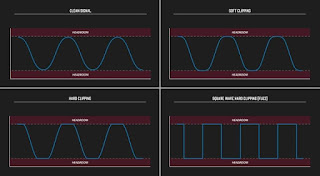Overdrive, Distortion and Fuzz
Broadly, when we talk about “overdrive”, distortion” and “fuzz”, we are talking about wave clipping, which happens when the signal exceeds the headroom of the amp.
Soft clipping is normally called “overdrive” and mimics the gain on your amp being turned up.
Hard clipping is more aggressive, cutting the peaks flat. This is called “distortion”.
When the wave form is so clipped that it turns a sine wave into a fully square shape, this is called “fuzz”.
Here’s a diagram:
Overdrive can be likened to a boost: it drives your amp harder so that the amp (rather than the effects pedal or app) creates the distortion. Think of overdrive in the way you might think of the gain on your amp (or the “power knob” if you one, which affects how much the gain knob drives the amp).
Obviously some “overdrive pedals” are just weaker distortion pedals (because they do more than drive the amp).
Likewise, some “distortion pedals” are really more like overdrives because they really don’t introduce a clip as much as lower the threshold for your amp to do it.
The same lack of precise differentiation exists between “fuzz” and “distortion”: when “hard clipping” turns into “fuzz” is somewhat subjective in terms of tone (guitar players don’t always zoom in on wave forms when describing an effect).
Exactly where the effect and the amp play a role is not always clear. Essentially, you have to see terms like “overdrive”, “distortion” and “fuzz” as part of a continuum.
Your pickups, effects pedals etc., amp and speakers all play a role. It’s not possible to divide the levels of distortion cleanly by cause or tone.
Accordingly, these terms are really labels in a continuum of wave clipping. But they are useful labels nonetheless.

Comments